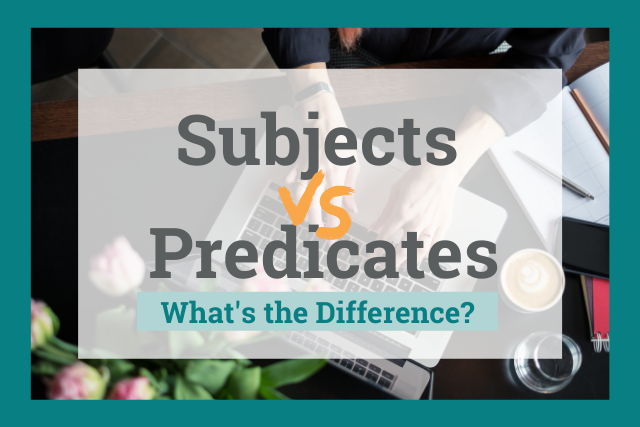
You might remember learning how to map the parts of a sentence at school. But if it’s been a while, or words like subjects and predicates drag up bad memories of school bullies and chalk dust, we’re here to refresh your memory.
Every complete sentence contains a subject (the who or what of the sentence) and a predicate (the part of the sentence that contains the action).
Each of these components plays a different role in the sentence.
Today, we’re going to cover everything you need to know about subjects and predicates.
What Is the Subject of a Sentence?
The subject is the who or what of a sentence. It is the person, place, or thing that is doing an action. In other words, the subject is what the sentence is about.
Let’s look at a few easy examples so we can better understand what a subject is.
The subject is in bold in the following sentences:
- Maria loves dogs.
- The boy climbed a tree.
- The chicken crossed the road.
In each of these examples, we can ask who or what the sentence is about to find the subject.
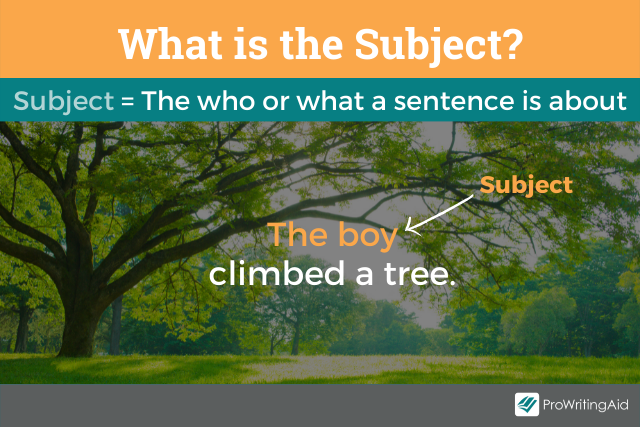
Who loves dogs? Maria. Who climbed a tree? The boy. What crossed the road? The chicken. (But why it crossed the road is for a different article!)
We often have more complicated sentences than those simple examples. Subjects can be simple, complete, or compound, but they still always answer the question who/what the sentence is talking about.
What Is the Difference Between a Simple, Complete, and Compound Subject?
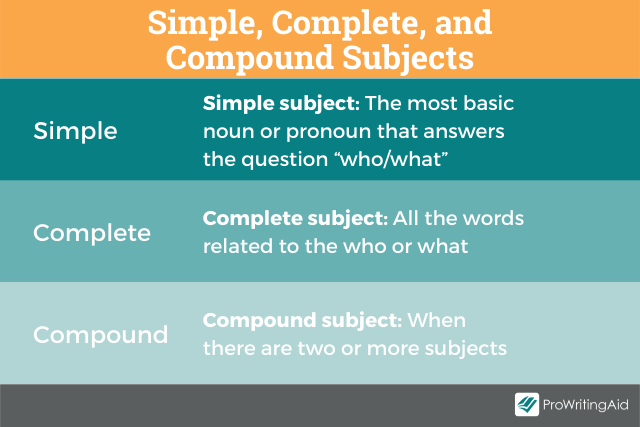
A simple subject is just the most basic noun or pronoun in the sentence. The examples above all feature simple subjects. There is no excess information.
A complete subject includes any additional descriptors or modifiers to the subject. It includes all the words that are not part of the predicate.
What do these look like in action? Let’s study an example.
- The little boy with a toothless grin fearlessly climbed the big, old oak tree.
The simple subject includes no extra information. If we trim all the fat, we are left with “the boy.” Who climbed the tree? The boy.
For the same example, the complete subject is “the little boy with a toothless grin.”
The complete subject includes the extra details to tell us which boy we are talking about. Who climbed the tree? The little boy with a toothless grin.
As you can see, there is a simple subject and a complete subject in the same sentence.
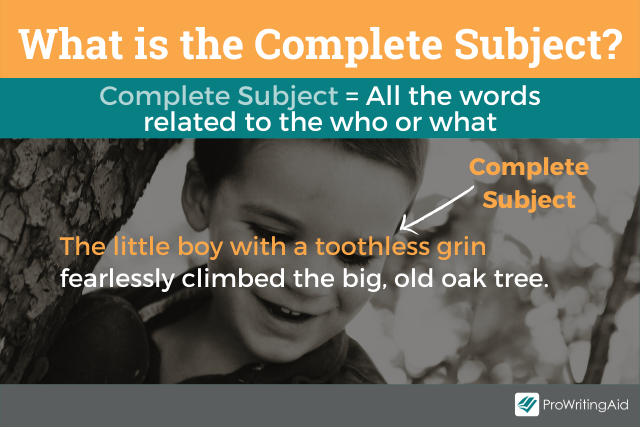
A compound subject occurs when there are two or more subjects in the same sentence. Let’s expand on our previous example.
- The little boy with a toothless grin and his older sister fearlessly climbed the big, old oak tree.
When we ask who climbed the tree, we have two answers: the boy and his sister. This is a compound subject.
How Do I Find the Subject in a Sentence?
Now that we know what a subject is, we need to know how to identify it in a sentence.
In most cases, finding the subject is easy. The subject often occurs at the beginning of a sentence. It almost always occurs directly before the predicate (the verb or verb phrase in the sentence).
The examples in the previous section followed this pattern. If you ask yourself, “Who or what is this sentence about?” you can typically find the subject.
In the case of passive voice, the subject typically follows the predicate. Consider this example:
- The tree was climbed by the boy.
We can still identify the subject by asking who climbed the tree. The answer is “the boy,” so that is still the subject.
Sometimes we write sentences in reverse order, like in the sentence below.
- Amongst the leaves was an acorn.
What is amongst the leaves? An acorn. When the sentence is structured this way, the subject follows the verb.
But what if you can’t easily answer the question, “Who or what is this sentence about?” Subjects aren’t always this clear-cut.
We’re going to dive into some other tricky types of sentences.
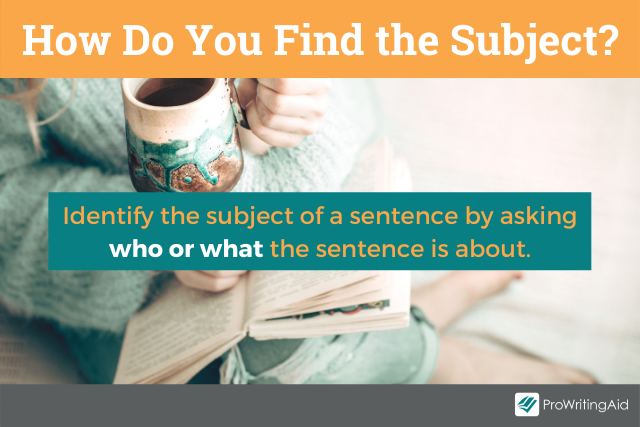
Where Is the Subject in an Imperative Sentence?
An imperative sentence gives a command.
- Go! Leave us. Stop bothering me!
These sentences appear to have no subject, but in fact the subjects are just invisible. The implied subject is “you.”
Who should go? You.
Who are we telling to leave us? You.
Who needs to stop bothering me? You.
(Well, not you, dear reader! You can stay.)
When in doubt, ask who the sentence is about, just like in the simpler examples, to find your answer.
Is “There” a Subject?
We often start sentences with the phrase “there is/are.” These sentences are called expletives. Check out these two examples.
- There is a dog in the window.
- There are five cupcakes left.
“There” is not the subject. In this case, the subject is actually in the middle of the sentence. What is in the window? A dog. What is left? Five cupcakes.
The sentences are not about “there.” They are about the dog and the cupcakes.
Is a Subject Always a Noun or Pronoun?
In every example so far, all of our subjects have been nouns. It’s also common to see pronouns as subjects, e.g. he, I, they.
These are usually what you’ll see when you’re looking for the subject of a sentence.
But sometimes subjects look different. They might contain a verb, usually a present participle or an infinitive.
But in these instances, the verbs aren’t functioning as a verb. They are functioning as nouns. These are called verbals.
Here is an example. The bold portion is the complete subject:
- Running a marathon is a great accomplishment.
If we ask what is a great accomplishment, the correct answer is running a marathon. The marathon itself is not the accomplishment; running it is crucial to the sentence.
Therefore, the subject is “running a marathon.” In this instance, running is not functioning as a verb.
What Is a Predicate?
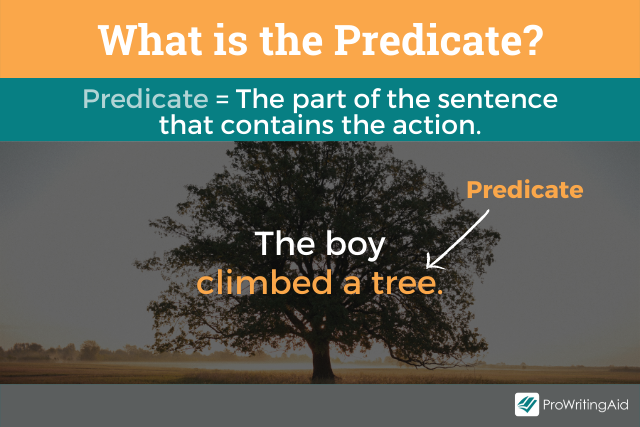
If the subject is what or who is doing the action, the predicate is the part of the sentence that contains the action. It tells us what the subject is doing.
By definition, the predicate is the part of the sentence that contains the verb or verb phrase. A verb phrase is when a verb is tied to one or more auxiliary (helping) verbs.
This type of phrase usually occurs when we are changing the tense of a verb.
For example, when we say, “I have eaten,” the verb phrase is “have eaten.” Have is the helping verb that modifies eaten.
Let’s go back to our original examples to understand predicates.
- Maria loves dogs.
- The boy climbed a tree.
- The chicken crossed the road.
The predicate contains the verb in each sentence. Predicates can be simple or complete, and they can also combine to make a compound predicate.
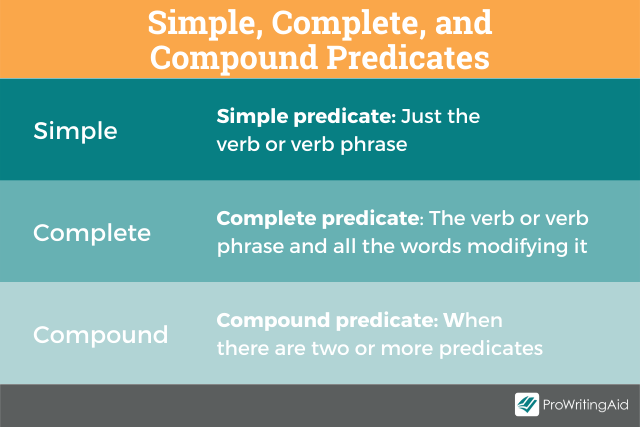
What Is the Difference Between a Simple Predicate and a Complete Predicate?
A simple predicate is just the verb or verb phrase. Let’s continue with the examples above.
What does Maria do? Loves.
What did the boy do? Climbed.
What did the chicken do? Crossed.
The simple predicate gets rid of any extra information, while the complete predicate includes all the words related to the verb.
- The little boy with the toothless grin fearlessly climbed the big, old oak tree.
We already know what the subject is. So, what did the little boy do? The simple predicate is “climbed.” The complete predicate is “fearlessly climbed the big, old oak tree.”
Any words that modify the verb or provide additional information are part of the complete predicate.

What Is a Compound Predicate?
Sometimes, a subject does more than one thing. Here, there might be a compound predicate.
A compound predicate is when there are two or more predicates tied to one subject. Check out this example.
- Maria loves dogs and hates cats.
What does Maria do? Loves dogs and hates cats. “Loves dogs” is a complete predicate. “Hates cats” is another complete predicate. Together, these make a compound predicate.
How Do I Find the Predicate of a Sentence?
Finding the predicate is as easy as finding the verb (the action of the sentence). You can ask yourself what the subject is doing. The answer is the predicate.
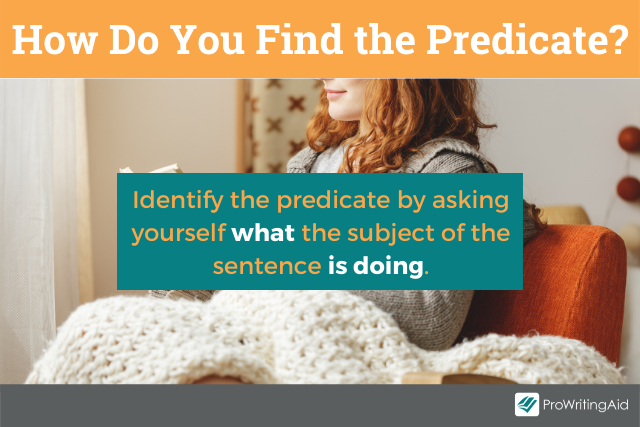
Usually, the predicate follows the subject, as we saw in the section about locating the subject.
In expletive sentences, the complete predicate may be broken into parts. Here’s an example.
- There is a dog in the window.
We know the subject is “a dog.” The verb is “is.” The complete predicate is “is... in the window.” This is because “there” isn’t part of the subject or the predicate.
If we were diagramming the sentence, “there” would be floating above the diagram.
But we don’t diagram sentences in real life, unless you’re a grammarian. Usually, the predicate will be much simpler to find.
How Do I Find the Subjects and Predicates in Compound or Complex Sentences?
Sentences that contain just one subject and predicate are called simple sentences. There are three other types of sentences—compound, complex, and compound-complex.
A compound sentence consists of two or more independent clauses joined by a coordinating conjunction.
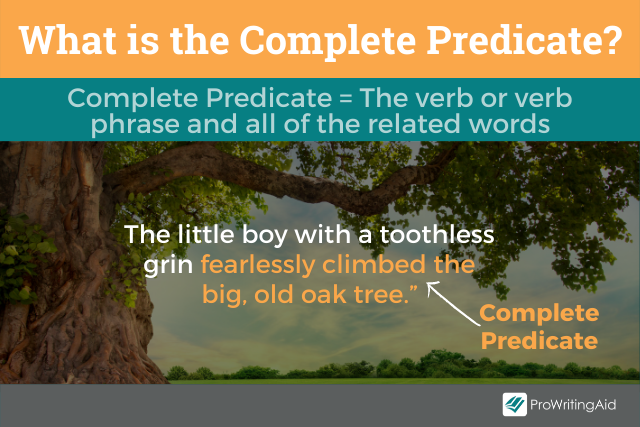
Typically a comma appears before the conjunction. ProWritingAid can help you make sure your commas are going in the correct spots in your sentences.
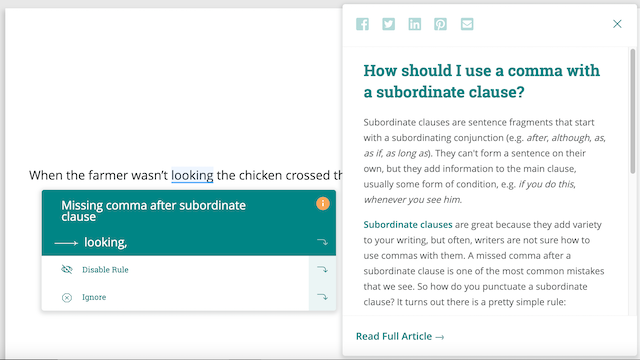
Try ProWritingAid’s browser extensions to make sure your grammar is top-notch wherever you write.
Now, consider the following compound sentence:
- The chicken crossed the road, and the duck flew away.
These independent clauses can stand alone as sentences. Each clause has a subject and predicate.
In the first, the subject is “the chicken” and the predicate is “crossed the road.” In the second clause, “the duck” is the subject and “flew away” is the predicate.
A complex sentence contains a dependent clause and an independent clause.
Even though the dependent clause cannot stand alone as a sentence, it still contains a subject and predicate, as does the independent clause.
Let’s turn that same sentence into a complex sentence. The subjects are bolded, and the predicates are highlighted.
- “The chicken crossed the road while the duck flew away.”
Easy enough, right? You can expect the same rule from a compound-complex sentence.
This type of sentence contains two or more independent and dependent clauses. Every clause contains a subject and predicate.
Here’s how it looks. Once again, the subjects are bolded, and the predicates are highlighted.
- “When the farmer wasn’t looking, the chicken crossed the road and the duck flew away.”
It doesn’t matter how long your sentence is—the subject is the who or what that the sentence is about, and the predicate is what the subject is doing.
Once you’ve mastered that principle, you can identify the subjects and predicates in any sentence.
What’s Next in Subjects and Predicates?
You’ve probably heard of subject-verb agreement. This principle is important with subjects and predicates.
The subject of a sentence must agree with the verb in the predicates. ProWritingAid can help you identify mismatched subjects and predicates.
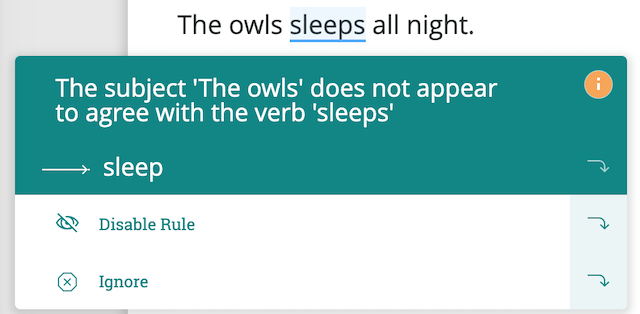
Sign up for a free ProWritingAid account to check your grammar now.


